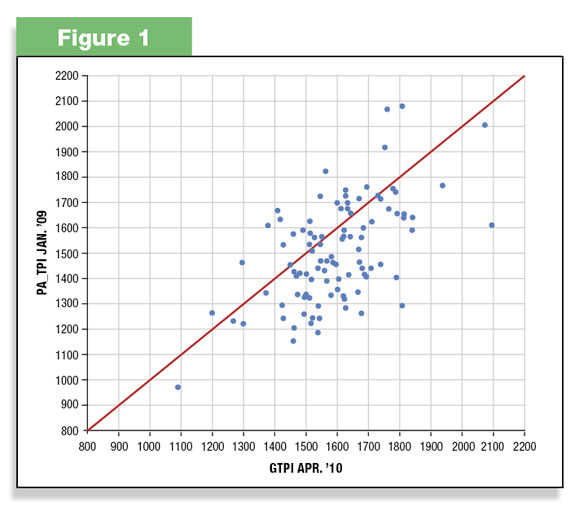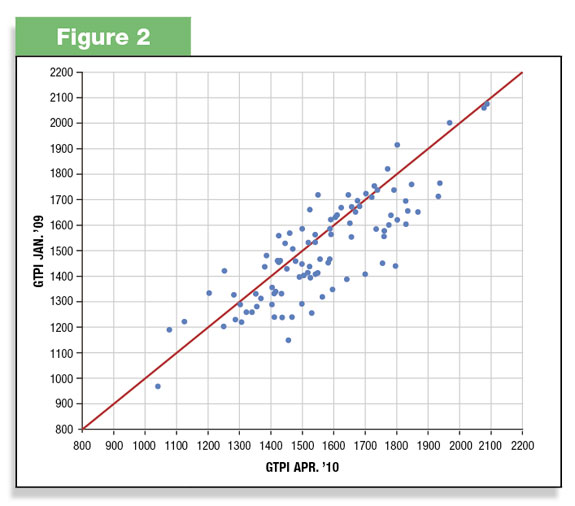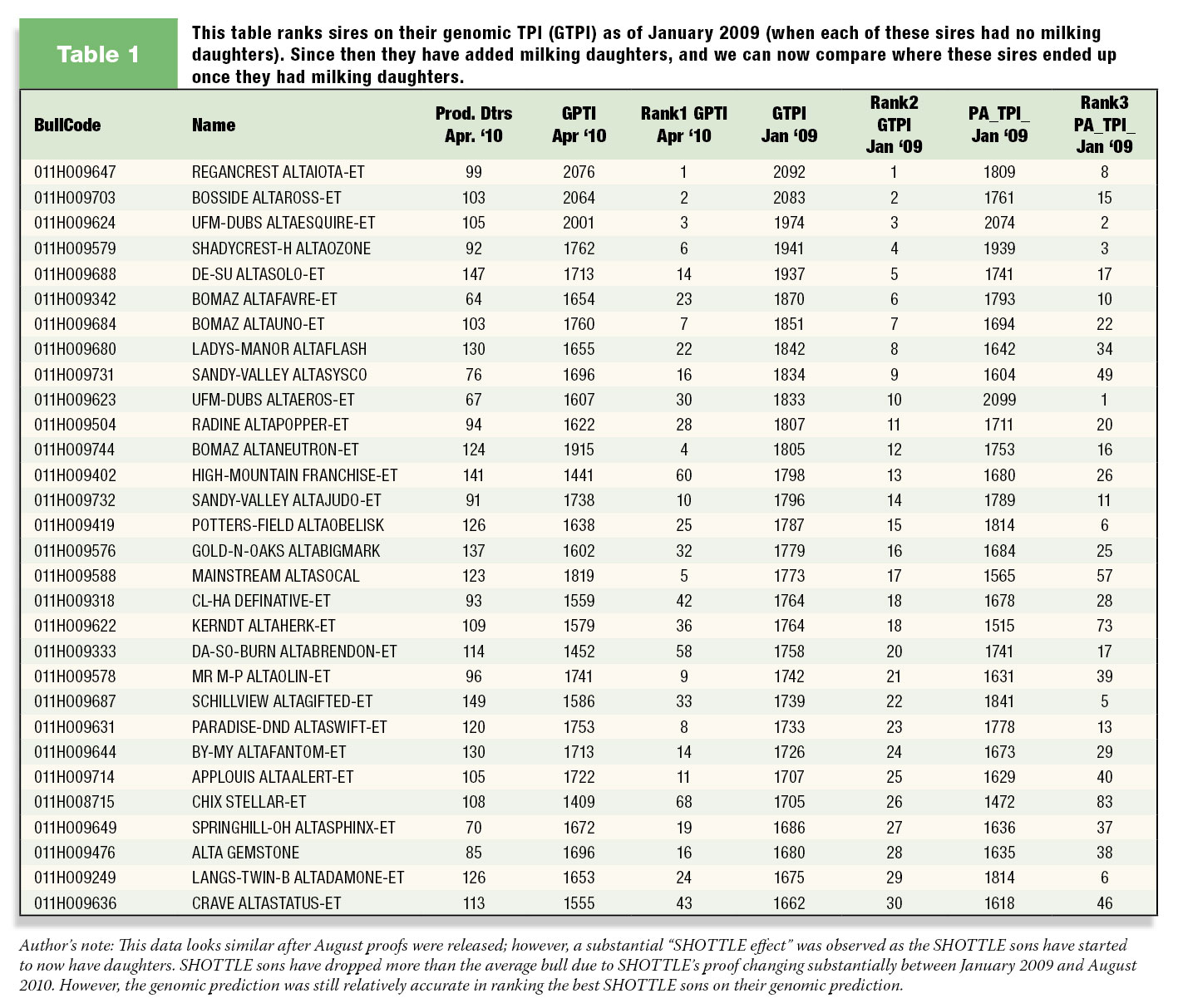TRENDING TOPIC ARTICLE: A.I. & BREEDING Published: September 1, 2010 print issue of Progressive Dairyman In this past article, Nate Zwald and Gerbrand van Burgsteden of Alta Genetics highlighted the benefits of genomics and the data to back it up. Scroll down or to jump to the article.
Because this article was so popular, we asked Zwald, “What initial advice would you give producers that aren’t currently using genomics but are interested in implementing this cattle breeding tool?”
Zwald says, “The easy opportunity for producers to benefit from genomics, is simply to set their genetic plan and then ensure that the best sires for that plan are being utilized. In nearly every genetic plan, the best sires are genomic sires.
"In this way, producers benefit from the genomic technology without changing their management. There are and will continue to be opportunities to utilize genomics on the females within herds as well, however the plan must be customized according to each herd.
"The identification accuracy of the herd, the genetic variation in the herd and the price paid for the test are all considerations in implementing the plan for a specific herd.
"However the most important consideration is the answer to the question: 'What will I do differently with the genomic results that I cannot do without that information?' Having a genetic plan is the first step for any herd looking to utilize genomic technology, whether it is on the male or female selection side.”
ARTICLE
No concept has been talked about more in the dairy cattle breeding world over the past two years than genomics. It is a very compelling science and has made genetics as popular of a topic as it was following the advent of artificial insemination.
But why is genomics such a big deal? The answer lies in the fact that genetic progress depends solely on four factors:
- 1. Selection intensity. When animals are selected based on a stricter regime, more progress will be made.
- Accuracy of selection. With a high reliability of proofs we are more certain that the better genetics will get passed on to offspring.
- Genetic variation. A large degree of difference (variation) between the best animals for a trait and the worst animals for a trait allows more progress to be made.
- Generation interval. The speed of genetic progress is faster when genes are passed from parent to offspring in a shorter period of time.
The power of genomics allows genetic proofs of cows and bulls to be estimated with a higher accuracy (reliability) at a younger age, which reduces the generation interval. Furthermore, as the accuracy of the ranking improves, we also can focus on only the best genetics, which improves selection intensity.
Genomics positively affects three of the four factors that cause genetic progress: selection intensity, accuracy and generation interval.
Questions we often encounter are: “Does this genomics stuff really work? Do we have to wait until genomic sires get daughter proofs to see how accurate the predictions really are?” This is a common misconception, which we will clarify.
Genomics have actually been “official” since January 2009. Therefore, more than 1,000 sires had genomic predictions with no daughters in January 2009 and now as of April 2010 proofs, have milking daughters. Therefore, we can use the daughter proof now to test the accuracy of the prediction from 18 months ago, when these bulls had no milking daughters. This group provides a very substantial dataset for the analysis of genomic proof accuracy and for what can be expected going forward.
Genomics should be seen as an extension to conventional cattle breeding strategies. In addition to the field data and pedigree information used in traditional genetic evaluations, genomics offers an extra source of information from the DNA of animals. The large impact of this new cattle breeding tool will be demonstrated here with an analysis of traditional evaluations compared to genomic evaluations.
For the purposes of this article we will use TPI as an index, which includes production, conformation and health traits in its calculation to determine the accuracy of genomics. This analysis could also be repeated with any other index or single trait with similar results.
In this analysis we compared the accuracy of the PA_TPI (traditional parent average TPI – all that was available for young bulls prior to genomics), the GTPI_Jan09 (Genomic prediction with no daughters from January 2009), and the GTPI_Apr10 (daughter proof from April 2010). AIPL has implemented some improvements to genomic predictions since January 2009, so therefore the ranking of the sires is going to be more important to compare than the actual GTPI values, but both are listed to make this as tangible as possible.
At our company, we had 101 sires that had a genomic prediction (no daughters) in January 2009, which now have a sufficient number of daughters for an official proof for both production and type in April 2010. The top 25 are listed in order of GTPI in January 2009 in Table 1 click image at left to open in a new window and you can see their corresponding rank now with milking daughters in April 2010 (out of 101 total).
Based on this data, if we selected the top three sires in January 2009 based on their GTPI’s at that time, we would have selected what have now become the top three daughter-proven sires in April 2010. The GTPI’s of these three sires in January 2009 averaged 2049 and their official daughter proofs now average 2047. Accuracy is obvious. However, before you quit reading to go buy the top genomic sires offered today, we need to make sure expectations are realistic, as similar results may not happen every time.
What if we used the top 10 sires for GTPI in January 2009?
Five of those sires would still be in the top 10 with their April 2010 daughter proof, seven of the 10 would be in the top 20, and all 10 would be in the top 30. The group did show an overall average decrease in TPI; however, the adjustments made in April 2010 to the genomic predictions on young bulls should lessen this drop in the future.
What happened on the low end of the spectrum? Will we miss some bulls by focusing on only those with the highest genomics?
The answer is very rarely. Only one of the bottom 20 sires for GTPI in January 2009 was in the top 50 sires after becoming daughter-proven in April 2010. Furthermore, of the top 10 daughter-proven bulls (April 2010), the lowest of the group was ranked No. 23 on GTPI in January 2009.
How do these results compare to what happened in the past?
In this analysis we also ranked sires based on traditional parent averages. With this method, only three of the top 10 parent average sires for TPI ultimately landed in the top 10 daughter-proven list for TPI in April 2010. The other seven bulls from the top 10 PA_TPI rank now between No. 20 and 85. The correlation of Parent Average TPI and daughter-proven GTPI was only .53, and this has increased to .84 when comparing initial GTPI with daughter-proven GTPI, so we have significantly improved our accuracy and predictive capability with genomics. With this kind of accuracy, there really is no such thing as a “young sire” (unknown genetic quality for cheap) anymore, as the accuracy of genomic sires is more comparable to traditional first-crop sires than traditional “young sires.”

Figures 1 and 2 show the increased predictability of TPI values when genomic information is included in the evaluation. The closer the scatter is to the red line, the more ideal the results.
It was previously mentioned that the group of GTPI sires shows an overall decrease in GTPI when daughter information is added. However, it should be noted that the average decrease in TPI is larger going from parent average in January 2009 to the April 2010 proof, than going from genomic proofs in January 2009 to April 2010. Changes in rank will still occur between the initial genomic prediction and daughter proof, yet these changes are not new. Bull proofs have always changed when more information is added. The situation with genomics is no different; however, changes will likely be less extreme. When evaluating these tables, remember that significant changes in rank for TPI have traditionally happened between first- and second-crop evaluations as well, and it certainly wasn’t uncommon for some sires to drop significantly because more information was added – the changes represented here are quite similar.

So what does this all mean?
Genomics can provide advantages to your herd both directly and indirectly. Indirect advantages are provided by your supplying A.I. company through the application of genomics in their breeding program. The information on the bulls’ parents, combined with genomic information, equals the power of about 30 producing daughters. So even when a bull has no daughters milking and genomic information is included in his proof, the proof is quite accurate and reliable. A.I. companies are now using young bulls as sires of sons. By shortening the generation interval and increasing the selection intensity, genetic progress and accuracy increase.
The direct advantages for your herd can be realized through the use of young genomic sires.
Should you use genomic proven sires, and if so, to what degree?
You can draw conclusions for yourself, and the decision is really a matter of risk. If you are breeding an individual cow and have very little tolerance for a mistake, you likely want to use a highly reliable bull. However, if you want to maximize the genetic gain of your entire herd and reach your breeding goal at a faster pace, genomic proven sires are certainly the way to achieve your goals. However, much like a stock portfolio, you will need to accept a bit of risk to maximize your expected return. Of course, risk can be mitigated in stocks by increasing the number of different companies owned, and with genomics, risk can be reduced by increasing the number of different sires used. So for those of you who wish to maximize your genetic gain and are willing to accept some risk to do so, make sure you set your genetic plan carefully. Then select a group of at least five to six sires that will help you maximize your progress towards your genetic plan. PD
References omitted due to spacebut are available upon request by sending an email to editor@progressivedairy.com .

-
Nate Zwald
- Alta Genetics
- Senior Manager
- Email Nate Zwald






